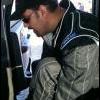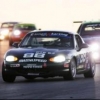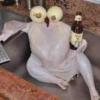You guys are trying to turn apples and bannanas into oranges. never going to happen. A gt3 car vs an old GM diagram vs a Miata with a lot of mis information.
To start, lets settle on some terminology.
The spindle is the metal spike that sticks out from the upright
There are 2 inner races, one inboard and one outboard. These are the silver metal parts you remove to gain access to the ball bearings
There are 2 sets of ball bearings that ride in a plastic retainer to keep them evenly spaced
The outer races for the ball bearings are machined into the hub, which also has the lug studs installed and spins with the wheel.
When assembled I will call it a front bearing assembly.
The inner races fit tight on the spindle and do NOT spin. Although not a precision fit, there is virtually no gap between the spindle and inner race inner diameter. The inboard inner race, when installed, bottoms out on the flange at the base of the spindle. When you tighten the nut, the outboard inner race must contact the inboard inner race. If it did not contact, the tension on the ball bearings would cause binding. Picture the 2 inner races installed with no hub or bearings. If the inner races had a gap between them, tightening the nut would decrease the gap in the "U" the ball bearings ride in. The positioning of the inner races has to be very precise. Just a couple thousands of an inch would cause bind or looseness. Any grease stuck between the inner races will change the relative positioning of the races. I feel this is why retorqueing the nut sometimes helps. This machine tolerance seems to be one of the differences between cheap and expensive bearings.
I do not feel the torque on the nut is going to squeeze the inner races enough to change their relative position. There is very little, if any preload on these bearings. Any endplay is what we are discussing here.
The diagram above from Dewy, shows a system as used by virtually all rear drive manufacturers for 50+ years. The key factor being the cotter pin to lock the nut in place. Neither the inner race (often referred to as a cup) nor the outer race (part of the bearing "cone") touch. End play/preload is adjusted by tightening the nut and then locking it in place with the cotter pin. There have been multiple versions of this system over the years, some use a castle nut, some a castled lock ring, some a bend over tab, some double nut, some have locking screws. But in all cases they use 2 sets of tapered bearings rather than our roller bearings.
I have seen both inner races and the outer bearing surface of the hub fail. I assume it is either of the races that fail first and not the bearings. Even poor quality ball bearings are pretty darn good.
My opinion; The original bearings with many thousands of miles are the best. The surfaces have work hardened them selves before we start abusing them. Even the super cheap ebay bearings would be fine for a daily driver. Driving style does seem contribute to bearing life. The more abusive to the front tires seem to be more abusive to the bearings also. repack any bearing with a high quality synthetic grease. I like Schaeffer grease, but CV2, Mobil etc all seem to be just as good.
For a perminant fix, someone smarter than me would need to design a hub similar to the one in Dewys diagram. It would utilize tapered roller bearings that could be replaced cheaply and still use the stock brake disc. I can visualize it in my head, but I am not a machinist. this would require a cotter pin hole to be drilled into the spindle. I would guess a rice of $300-$600 per pair.
That's what I think
Dave
Dave Wheeler
Advanced Autosports, the nations most complete Spec Miata shop
Author, Spec Miata Constructors Guide, version 1 and 2.0
Building Championship winning cars since 1995
4 time Central Division Spec Miata Champion car builder 2012-2013-2014-2017
Back to Back June Sprints Spec Miata 1-2 finishes 2016 and 2017
5 time June Sprints winner in Mazda's
6 Time Northern Conference Champion Car Builder
2014 SCCA Majors National point Champion car builder
2014 SCCA Runoffs winner, T4 (Bender)
2014 Central Division Champion, ITS (Wheeler)
2013 Thunderhill 25 hour winning crew chief
2007 June Sprints winner, (GT1, Mohrhauser)
Over 200 race wins and counting.
www.advanced-autosports.com
dave@advanced-autosports.com
608-313-1230





 Sign In
Sign In Create Account
Create Account









 Back to top
Back to top Report
Report













